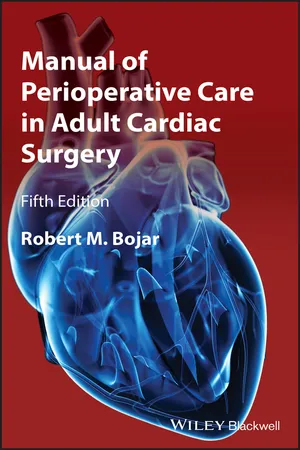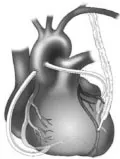
eBook - ePub
Manual of Perioperative Care in Adult Cardiac Surgery
Robert M. Bojar
This is a test
- English
- ePUB (handyfreundlich)
- Über iOS und Android verfügbar
eBook - ePub
Manual of Perioperative Care in Adult Cardiac Surgery
Robert M. Bojar
Angaben zum Buch
Buchvorschau
Inhaltsverzeichnis
Quellenangaben
Über dieses Buch
The fifth edition of Bojar's Manual of Perioperative Care in Adult Cardiac Surgery remains the gold standard for management of adult patients undergoing cardiac surgery.
The easily referenced outline format allows health practitioners of all levels to understand and apply basic concepts to patient care--perfect for cardiothoracic and general surgery residents, physician assistants, nurse practitioners, cardiologists, medical students, and critical care nurses involved in the care of both routine and complex cardiac surgery patients.
This comprehensive guide features:
- Detailed presentation addressing all aspects of perioperative care for adult cardiac surgery patients
- Outline format allowing quick access to information
- Chronological approach to patient care starting with diagnostic tests then covering preoperative, intraoperative, and postoperative care issues
- Additional chapters discuss bleeding, the respiratory, cardiac, and renal subsystems as well as aspects of care specific to recovery on the postoperative floor
- Updated references, information on new drug indications and new evidence to support various treatment/management options.
Practical and accessible, this new edition of Manual of Perioperative Care in Adult Cardiac Surgery is the essential reference guide to cardiac surgical patient care.
Häufig gestellte Fragen
Wie kann ich mein Abo kündigen?
Gehe einfach zum Kontobereich in den Einstellungen und klicke auf „Abo kündigen“ – ganz einfach. Nachdem du gekündigt hast, bleibt deine Mitgliedschaft für den verbleibenden Abozeitraum, den du bereits bezahlt hast, aktiv. Mehr Informationen hier.
(Wie) Kann ich Bücher herunterladen?
Derzeit stehen all unsere auf Mobilgeräte reagierenden ePub-Bücher zum Download über die App zur Verfügung. Die meisten unserer PDFs stehen ebenfalls zum Download bereit; wir arbeiten daran, auch die übrigen PDFs zum Download anzubieten, bei denen dies aktuell noch nicht möglich ist. Weitere Informationen hier.
Welcher Unterschied besteht bei den Preisen zwischen den Aboplänen?
Mit beiden Aboplänen erhältst du vollen Zugang zur Bibliothek und allen Funktionen von Perlego. Die einzigen Unterschiede bestehen im Preis und dem Abozeitraum: Mit dem Jahresabo sparst du auf 12 Monate gerechnet im Vergleich zum Monatsabo rund 30 %.
Was ist Perlego?
Wir sind ein Online-Abodienst für Lehrbücher, bei dem du für weniger als den Preis eines einzelnen Buches pro Monat Zugang zu einer ganzen Online-Bibliothek erhältst. Mit über 1 Million Büchern zu über 1.000 verschiedenen Themen haben wir bestimmt alles, was du brauchst! Weitere Informationen hier.
Unterstützt Perlego Text-zu-Sprache?
Achte auf das Symbol zum Vorlesen in deinem nächsten Buch, um zu sehen, ob du es dir auch anhören kannst. Bei diesem Tool wird dir Text laut vorgelesen, wobei der Text beim Vorlesen auch grafisch hervorgehoben wird. Du kannst das Vorlesen jederzeit anhalten, beschleunigen und verlangsamen. Weitere Informationen hier.
Ist Manual of Perioperative Care in Adult Cardiac Surgery als Online-PDF/ePub verfügbar?
Ja, du hast Zugang zu Manual of Perioperative Care in Adult Cardiac Surgery von Robert M. Bojar im PDF- und/oder ePub-Format sowie zu anderen beliebten Büchern aus Medicina & Cardiología. Aus unserem Katalog stehen dir über 1 Million Bücher zur Verfügung.
Information

Synopsis of Adult Cardiac Surgical Disease
Coronary Artery Disease
Left Ventricular Aneurysm
Ventricular Septal Rupture
Aortic Stenosis
Aortic Regurgitation
Mitral Stenosis
Mitral Regurgitation
Tricuspid Valve Disease
Endocarditis
Hypertrophic Obstructive Cardiomyopathy
Aortic Dissections
Thoracic Aortic Aneurysms
Atrial Fibrillation
Ventricular Tachycardia and Sudden Death
End-Stage Heart Failure
Pericardial Disease
Congenital Heart Disease: Atrial Septal Abnormalities
Adults with Other Congenital Heart Disease

It is essential that all individuals involved in the assessment and management of patients with cardiac surgical disease have a basic understanding of the disease processes that are being treated. This chapter presents the spectrum of adult cardiac surgical disease that is encountered in most cardiac surgical practices. The pathophysiology, indications for surgery, specific preoperative considerations, and surgical options for various diseases are presented. Diagnostic techniques and general preoperative considerations are presented in the next two chapters. Issues related to cardiac anesthesia and postoperative care specific to most of the surgical procedures presented in this chapter are discussed in Chapters 4 and 8, respectively. The most current guidelines for the evaluation and management of patients with cardiac disease can be obtained from the American College of Cardiology website (www.acc.org).
I. Coronary Artery Disease
A. Pathophysiology. Coronary artery disease (CAD) results from progressive blockage of the coronary arteries by atherothrombotic disease. Significant risk factors include hypertension, dyslipidemia (especially high LDL and low HDL levels), diabetes mellitus, cigarette smoking, and obesity. Clinical syndromes result from an imbalance of oxygen supply and demand resulting in inadequate myocardial perfusion to meet metabolic demand (ischemia). Progressive compromise in luminal diameter producing supply/demand imbalance usually produces a pattern of chronic stable angina. Plaque rupture with superimposed thrombosis is responsible for most acute coronary syndromes (ACS), which include classic “unstable angina”, non-ST-elevation myocardial infarctions (NSTEMI), and ST-elevation infarctions (STEMI). Interestingly, plaque rupture commonly occurs in coronary segments that are not severely stenotic. Endothelial dysfunction has become increasingly recognized as a contributing factor to worsening ischemic syndromes. Generalized systemic inflammation, indicated by elevated C-reactive protein levels, is usually noted in patients with ACS, and appears to be associated with adverse outcomes.1
B. Management strategies
1. Symptomatic coronary disease is initially treated with medical therapy, including aspirin, nitrates, and β-adrenergic blockers. Calcium channel blockers (CCBs) are considered if β-blockers are contraindicated. Statins should be given to control dyslipidemias and are effective for plaque stabilization. Angiotensin-converting enzyme (ACE) inhibitors are used for control of hypertension, especially in patients with compromised left ventricular function. Clopidogrel generally does not provide benefit to patients with chronic stable angina, except in selected subsets, but is beneficial in patients with an ACS.2–6
2. STEMIs are preferentially treated by percutaneous coronary intervention (PCI) (angioplasty and stenting), although thrombolytic therapy may be considered when PCI cannot be performed within a few hours. Clinical benefit is time-related (“time is myocardium”), and the best results are obtained with “door to balloon” times less than 90 minutes. However, myocardial salvage may still occur if reperfusion can be accomplished within 6 hours of the onset of chest pain.7,8
3. Patients presenting with an ACS should be treated with aspirin and unfractionated or low-molecular-weight heparin (LMWH), as well as the standard therapy listed above (nitrates, β-blockers, statins).9,10 Clopidogrel may provide clinical benefit to these patients if they are to be treated medically, and it may be given if an early invasive strategy is proposed. The 2007 ACC/AHA recommendations were that it should not be given if urgent surgery is considered likely, but this can be difficult to predict and therefore it is given routinely. Most studies have shown that 30-day outcomes are better in patients undergoing coronary artery bypass graft (CABG) surgery who initially received clopidogrel.2–6 However, one study showed that there was no difference in outcomes whether clopidogrel was given or not if patients had surgery within 5 days, but outcome was better if it was initially given on presentation, then stopped for at least 5 days before surgery.11 This study supports the ACC/AHA recommendation that clopidogrel be stopped at least 5 days before surgery except in urgent or emergent situations.9 If prasugrel is given in anticipation of PCI, but CABG is recommended instead, it should be stopped at least 7 days prior to surgery.
4. In patients with continuing ischemia and high-risk features (crescendo angina over 48 hours, rest pain, ECG changes at rest, congestive heart failure [CHF], hemodynamic instability, or an elevated troponin level), platelet glycoprotein IIb/IIIa inhibitors, such as tirofiban or eptifibatide, may be added to the regimen with plans to proceed to an early invasive strategy of catheterization. At that time, the appropriate means of intervention (PCI vs. CABG) can be determined. If a IIb/ IIIa inhibitor is used and a clopidogrel load is not given prior to PCI, it will provide antiplatelet activity until the initial dosing of clopidogrel achieves adequate platelet inhibition (a few hours after a 600 mg load). Numerous trials are evaluating the role of various platelet inhibitors and the use of bivalirudin rather than heparin during PCI.
C. Selection of an interventional procedure
1. An assessment of the patient’s clinical presentation, the extent and nature of coronary disease, degree of inducible ischemia on stress testing, and status of ventricular function are taken into consideration when determining whether the patient is an appropriate candidate for an interventional procedure.12 In patients with convincing evidence of an ACS, stress tests are not indicated prior to cardiac catheterization. The primary objective of any intervention is the relief of ischemia to prevent or minimize the extent of myocardial damage.
2. PCI has seen wide applicability beyond its proven benefit in early randomized trials, which generally had very selective inclusion criteria. It is often preferable to surgery in patients presenting with STEMIs or with ongoing ischemia with NSTEMIs because it can more promptly salvage myocardium – unless the anatomy is such that CABG is preferable (see below). The benefits of PCI in patients with chronic stable angina are not as well defined.13,14
3. The indications for PCI in multivessel disease are controversial. Although several studies suggest that CABG improves long-term survival better than PCI, other trials indicate that survival is comparable, although more patients undergoing PCI require reintervention.15–20 The rationale is that PCI only addresses focal lesions despite CAD being a multifocal disease, whereas CABG bypasses the entire proximal segment. Thus, repeat intervention, usually in sites other than the original stent location, is much more likely if PCI is utilized. Evidence-based guidelines have been established by major organizations to identify when PCI and/or CABG is indicated (Figures 1.1 and 1.2).12 These guidelines will continue to evolve when the results of additional trials including multivessel and left main disease,21–23 reoperative situations, varying patient subpopulations, and newer stent technologies become available. One approach to decision making is use of the SYNTAX score (accessible at www.syntaxscore.com), which assesses the extent and nature of coronary artery disease and provides comparative major adverse cardiac event (MACE) rates for PCI and CABG for multivessel as well as left main disease.23–25 Use of such data can provide patients with adequate evidence-based clinical information to give informed consent for any interventional procedure.
4. Although drug-eluting stents (DES) are associated with a lower risk of restenosis than bare-metal stents (BMS), most studies have not shown a significant impact on the risk of myocardial infarction or death.26 In fact, the risk of stent thrombosis is greater with DES, and this is accentuated in patients who are resistant to the antiplatelet effects of aspirin and/or clopidogrel.27 Platelet function testing may be beneficial in determining which patients are resistant to their antiplatelet effects. To minimize the risk of stent thrombosis, it is recommended that patients receiving BMS take aspirin and clopidogrel for at least 1 month, and those receiving DES take these medications for at least 1 year.28
5. One should not consider either PCI or CABG an exclusive approach to a patient’s coronary artery disease. For example, one hybrid approach is to perform a PCI of the culprit lesion in an unstable patient in the interest of myocardial salvage and then refe...